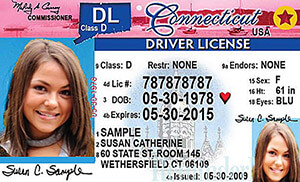- Updated for March 2025
- Based on official Connecticut Driver's manual
Free Connecticut DMV Permit Practice Test 2025
There are two main steps to obtaining a learner’s permit in Connecticut: Passing the vision screening and passing the written permit knowledge test. The Connecticut learner permit test consists of 25 multiple-choice questions covering road signs, state traffic laws, and safe driving practices. To pass the test, you must answer at least 20 questions (80%) correctly. In Connecticut, if you fail the test, you must wait seven days to retake it. That’s quite a lengthy wait, so use our resources to make sure that doesn’t happen. All knowledge tests must be taken in person at the DMV.
In Connecticut, the Graduated Driver’s License (GDL) program is designed to incrementally introduce driving privileges for applicants under 18 instead of granting the full license immediately. The GDL system applies to drivers under 18 and includes restrictions such as curfews and passenger limitations. It ends when the individual turns 18 or after completing a specified period with a clean driving record. During the permit phase, you must drive with someone who is at least 20 years old, has held a driver’s license for at least 4 years with no suspensions, and is seated in the front passenger seat. Also, you are prohibited from driving between 11 PM and 5 AM and must complete a mandatory 8-hour safe driving practices course during this phase. You must hold your learner’s permit for 120 days or 180 days (depending on whether your training was from a driver’s education course or parents, respectively) before moving to the provisional license stage.
Updated for March 2025, our free online Connecticut Permit Practice Test mimics what you will face on the official written test. It will help you pass by providing questions and answers based on the Connecticut DMV 2025 Driver Handbook. By providing instant feedback, our practice tests let you know right away why a response is the best one.
Once you’re ready, go to the DMV with proof of identity (birth certificate or passport), proof of residency (utility bill, rental agreement, or the like), and proof of Social Security number. If you’re under 18, parental consent and proof of school enrollment are also required. Submit the documents, pass a vision screening, pay the fee, and take the official written test.
Please check out our other free Connecticut DMV permit practice tests!
- Perfect for learner’s permit, driver’s license, and Senior Refresher Test
- Triple-checked for accuracy
What you need to know

What to expect on the actual CT DMV exam
questions
correct answers to pass
passing score
minimum age to apply
List of questions (classic view)
- Vertical rectangular signs with black letters on a white background are
- What does this sign mean?
- What does this sign mean?
- What does this sign mean?
- What might this sign mean?
- This sign indicates that you are approaching
- What does this sign mean?
- What do these yellow pavement markings mean?
- The number on this sign represents
- What does this sign indicate?
- To pass the DMV vision test, your visual acuity must be ______ or better.
- If your driver's license says you must wear corrective lenses and you are stopped by a law enforcement officer while you're not wearing them,
- A licensed driver under 18 years of age may not drive between _________ except for church, school, employment, medical necessity, or emergencies.
- If your vehicle fails an emissions inspection, you will have ________ to have the problem fixed and the emissions rechecked.
- Which of the following statements about turning is FALSE?
- Unbalanced tires or low tire pressures can cause
- If your vehicle doesn't have antilock brakes (ABS) and your brakes fail while you're driving, what should you do?
- In Connecticut, you may not park your vehicle
- In Connecticut, a driver who is at least 18 years of age
- Which of the following statements about seat belts is FALSE?
- When turning sharp corners, turn the steering wheel using the
- Safer drivers tend to look at least _________ ahead of their vehicles.
- Before turning right at an intersection, you should make sure that there is no traffic approaching
- If you see or hear an emergency vehicle using a siren, air horn, or a red or blue flashing light approaching from any direction, you must
- If you enter an intersection and there isn't sufficient space on the opposite side of the intersection to accommodate your vehicle, you may end up obstructing traffic. This situation is commonly known as
- Blind pedestrians may carry _________ canes or use the assistance of guide dogs.
- In Connecticut, when must you yield the right-of-way to a bicyclist?
- What should you do when you approach a horse and rider on a roadway?
- If you're being tailgated (followed closely), you should
- At 55 mph on a two-lane road, you need about ________ to pass another vehicle safely.
- If it feels like your tires have lost traction with the surface of the road, you should
- When you see a flashing yellow traffic light at an intersection, you should
- If you fail a chemical test for Blood Alcohol Content (BAC), your driver's license will be suspended for at least
- A dashed yellow line alongside a solid yellow line indicates that
- In Connecticut, you may not park within ________ of a fire hydrant.
- When you are driving at night and there are no other vehicles within 500 feet, you should
- Which of the following statements about railroad crossings is FALSE?
- Which of the following statements is FALSE?
- The correct hand signal to indicate a right turn is
- Which of the following right-of-way rules is FALSE?
FAQs
Can the permit test be taken online?
In Connecticut, the permit test must be taken in person at a DMV office. Online testing options are not currently available for the permit test.
What are effective study methods for the permit test?
Preparing for the permit test involves a thorough review of the Connecticut Driver's Manual and taking practice tests to familiarize yourself with the test format and question styles.
How challenging is the learner's permit test?
The difficulty level of the learner's permit test varies per individual, but with proper preparation, including studying the Driver's Manual and taking practice tests, it's generally manageable.
What are the requirements to obtain a permit?
To get a permit, you need to provide proof of identity, proof of Connecticut residency, pass a vision test, and successfully complete the written knowledge test.
How much does the permit test cost?
The cost for the permit test in Connecticut is approximately $40, which includes the fee for both the knowledge test and the learner's permit. It's advisable to check the latest fees on the Connecticut DMV website.
More resources
- Alabama: Test 1 / Test 2
- Alaska: Test 1 / Test 2
- Arizona: Test 1 / Test 2
- Arkansas: Test 1 / Test 2
- California: Test 1 / Test 2
- Colorado: Test 1 / Test 2
- Connecticut: Test 1 / Test 2
- Delaware: Test 1 / Test 2
- District of Columbia: Test 1 / Test 2
- Florida: Test 1 / Test 2
- Georgia: Test 1 / Test 2
- Hawaii: Test 1 / Test 2
- Idaho: Test 1 / Test 2
- Illinois: Test 1 / Test 2
- Indiana: Test 1 / Test 2
- Iowa: Test 1 / Test 2
- Kansas: Test 1 / Test 2
- Kentucky: Test 1 / Test 2
- Louisiana: Test 1 / Test 2
- Maine: Test 1 / Test 2
- Maryland: Test 1 / Test 2
- Massachusetts: Test 1 / Test 2
- Michigan: Test 1 / Test 2
- Minnesota: Test 1 / Test 2
- Mississippi: Test 1 / Test 2
- Missouri: Test 1 / Test 2
- Montana: Test 1 / Test 2
- Nebraska: Test 1 / Test 2
- Nevada: Test 1 / Test 2
- New Hampshire: Test 1 / Test 2
- New Jersey: Test 1 / Test 2
- New Mexico: Test 1 / Test 2
- New York: Test 1 / Test 2
- North Carolina: Test 1 / Test 2
- North Dakota: Test 1 / Test 2
- Ohio: Test 1 / Test 2
- Oklahoma: Test 1 / Test 2
- Oregon: Test 1 / Test 2
- Pennsylvania: Test 1 / Test 2
- Rhode Island: Test 1 / Test 2
- South Carolina: Test 1 / Test 2
- South Dakota: Test 1 / Test 2
- Tennessee: Test 1 / Test 2
- Texas: Test 1 / Test 2
- Utah: Test 1 / Test 2
- Vermont: Test 1 / Test 2
- Virginia: Test 1 / Test 2
- Washington: Test 1 / Test 2
- West Virginia: Test 1 / Test 2
- Wisconsin: Test 1 / Test 2
- Wyoming: Test 1 / Test 2
Your go-to, trusted source
Experience the Driving-Tests differenceOur commitment to accuracy and quality in our practice tests
Explore our rigorous, multi-tiered verification process that ensures each question mirrors the official manual for unparalleled accuracy.

At Driving-Tests.org, we understand the importance of reliable and accurate practice tests to help you prepare for your DMV exam. That's why we've developed a meticulous process to create and continually update our practice questions, ensuring they reflect the most current driving laws and regulations.
Here's an inside look at how we maintain the highest quality in our practice tests.
Content Creation and Verification Process
- Alignment with Official Manuals:
Every question we develop is based on the most recent version of each state's official driving manual. Our team regularly monitors each state DMV's website for the latest updates to ensure our practice tests are always aligned with the most current information. - Community Feedback Integration:
We leverage feedback from our vast community of users to understand which topics are most frequently tested. This helps us focus on the areas that are most relevant and beneficial for your preparation. - Expert Content Creation:
Our in-house editor, Steven, who has extensive experience in driver education, crafts each question with precision. He conducts a thorough review of each question against the official manuals to ensure accuracy. - Rigorous Review Process:
Once Steven has finalized a set of questions, our team conducts a joint review session. This second level of scrutiny involves content accuracy, proofreading, and fact-checking to eliminate any errors. - User Feedback Mechanism:
After a question goes live on our site, we keep the lines of communication open. Each question features a feedback button, inviting users to report any issues or errors. This continuous feedback loop allows us to address and rectify any concerns promptly. - Responsive Updates:
In line with our commitment to accuracy, we quickly update our practice questions to reflect any changes in the DMV manuals. Additionally, we update the free electronic copy of the state's driver's license manuals on our site, typically within a few days after the DMV publishes them.
Our thorough quality control process ensures that you have access to practice tests that are as accurate and up-to-date as possible. We believe in the power of well-prepared drivers and are dedicated to providing you with the best study tools to help you succeed on your DMV exam.
Pass the First Time - Guaranteed
Before you view your test results, discover how you can pass faster with Premium:
Real Exam-Like Connecticut Questions
Get 650+ questions seen on the real test
Money-Back Guarantee
If you don't pass, it costs you nothing
97% Premium Users Pass on Their First Try
Compare with the average US passing rate of 49%
